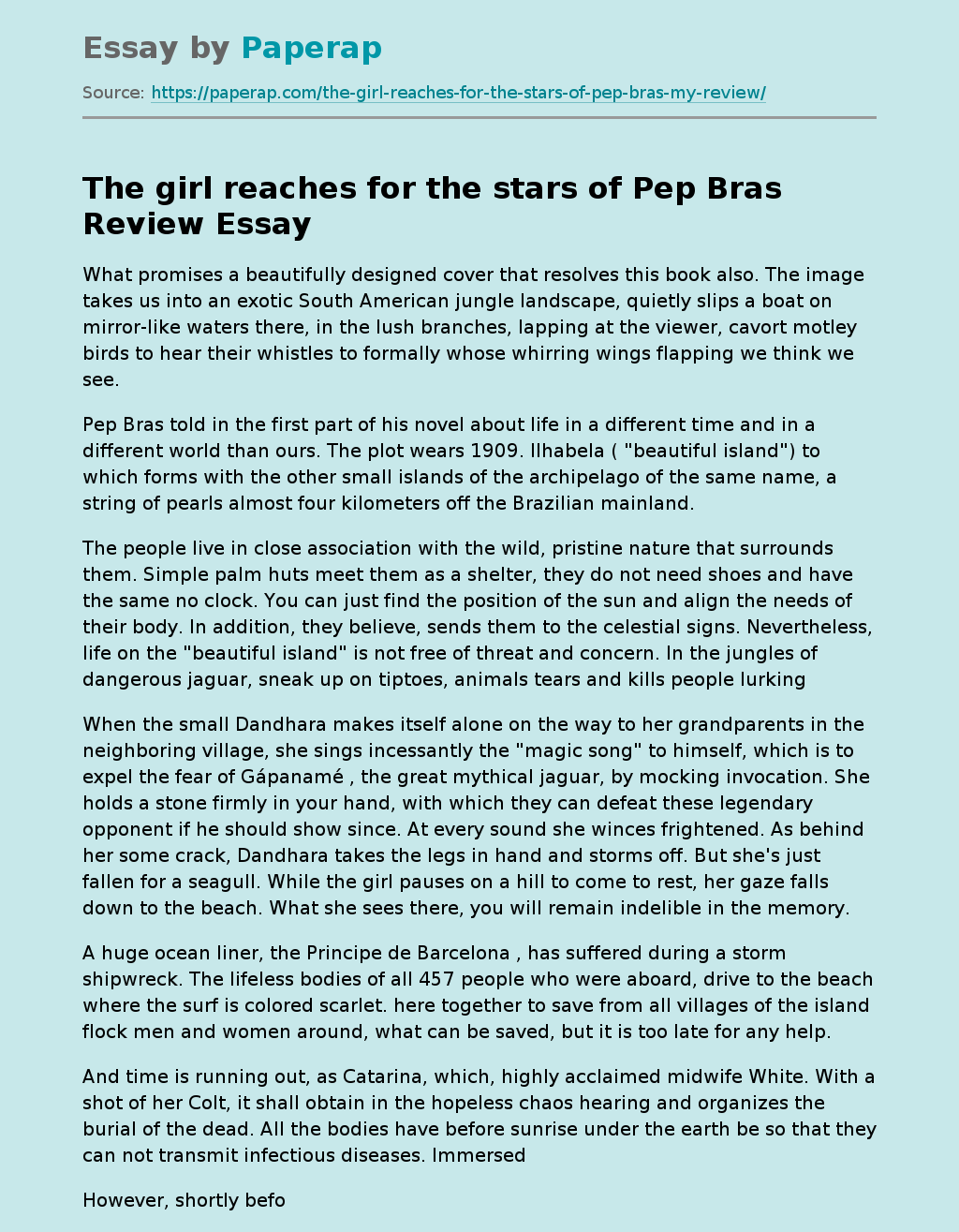What promises a beautifully designed cover that resolves this book also. The image takes us into an exotic South American jungle landscape, quietly slips a boat on mirror-like waters there, in the lush branches, lapping at the viewer, cavort motley birds to hear their whistles to formally whose whirring wings flapping we think we see.
Pep Bras told in the first part of his novel about life in a different time and in a different world than ours. The plot wears 1909.
Ilhabela ( “beautiful island”) to which forms with the other small islands of the archipelago of the same name, a string of pearls almost four kilometers off the Brazilian mainland.
The people live in close association with the wild, pristine nature that surrounds them. Simple palm huts meet them as a shelter, they do not need shoes and have the same no clock. You can just find the position of the sun and align the needs of their body. In addition, they believe, sends them to the celestial signs.
Nevertheless, life on the “beautiful island” is not free of threat and concern. In the jungles of dangerous jaguar, sneak up on tiptoes, animals tears and kills people lurking.
When the small Dandhara makes itself alone on the way to her grandparents in the neighboring village, she sings incessantly the “magic song” to himself, which is to expel the fear of Gápanamé , the great mythical jaguar, by mocking invocation. She holds a stone firmly in your hand, with which they can defeat these legendary opponent if he should show since.
At every sound she winces frightened. As behind her some crack, Dandhara takes the legs in hand and storms off. But she’s just fallen for a seagull. While the girl pauses on a hill to come to rest, her gaze falls down to the beach. What she sees there, you will remain indelible in the memory.
A huge ocean liner, the Principe de Barcelona , has suffered during a storm shipwreck. The lifeless bodies of all 457 people who were aboard, drive to the beach where the surf is colored scarlet. here together to save from all villages of the island flock men and women around, what can be saved, but it is too late for any help.
And time is running out, as Catarina, which, highly acclaimed midwife White. With a shot of her Colt, it shall obtain in the hopeless chaos hearing and organizes the burial of the dead. All the bodies have before sunrise under the earth be so that they can not transmit infectious diseases.
However, shortly before completing the strenuous work far out on the horizon a fine silhouette from the sea. unreal irradiated the day from the first light, the exhausted people notice a tab on the waves – and are horrified. The devil must be who wants to bring his dead! “And if he does not find them, it takes all of us as a pledge!” Only Catarina keeps a level head. To make the time Humbug an end, it demands to be rowed out to sea, so she can see the supposed Satan’s eyes. Catarina is not only found that the rider in bronze (The steamer sculptural group had invited the Spanish state gift for Argentina.) But discovered at its foot a more human figure, the face in the water, dressed in black, male, some twenty years old.
as from the recovered body a “living dead” is, before it creeps all for some time, and how is it that he his savior takes two years, two months and seven days to woman later that Pep Bras tells a fascinating, imaginative, sensitive manner. He gives the story also a (fictitious) autobiographical background: Joan Bras, the only survivor of the (also fictional) maritime disaster of 14 August 1909 his great-grandfather had been. On Ilhabela he spent with Catarina and their daughter Sión the happiest time of his life – until he Gápanamé before his eyes the woman robbed.
Change With this drastic accident scene of the action and. The atmosphere. Desperate leaves Joan the island and even his child for some years behind it, marries Isabelle, the beautiful daughter of a wealthy French investor, and eventually moved with her and the now eight-year Sión to Paris. A blatant contrast than between the “beautiful island” and the European metropolis can hardly imagine. Here “années folles les”, the wild twenties romp. The whole city seems in permanent Partyrausch. Artists, writers, rich from around the world meet here to inspire your senses and their creativity. You meet in bars, cafes, fine restaurants, visiting theaters, galleries and museums, enjoying himself in cabarets and variety shows. One wants to be not only seen but notice advance to become the topic of conversation.
Joan and his wife mix the middle with the hustle and bustle. The marriage has made Joan a wealthy man and catapulted into the upper class, but happy he is not new in the role of gentleman even in his marriage. In the slipstream of parental problems Sión can go relatively undisturbed own way. In a vaudeville idea they discovered a form of expression that continues its inclinations and talents from childhood: Already on Ilhabela were made of straw-made dolls with which they played, and said, their best friends; now they want as good a ventriloquist such as the well-known artist who is able to hit the sophisticated and pampered Parisian public under its spell. Their further course of development zeitigt dramatic consequences for Isabelle and Joan, suggesting once again violently refuse at the end of the novel up the voltage curve.
The Girl Reaches For The Stars Of Pep Bras Review. (2019, Nov 18). Retrieved from https://paperap.com/the-girl-reaches-for-the-stars-of-pep-bras-my-review/

